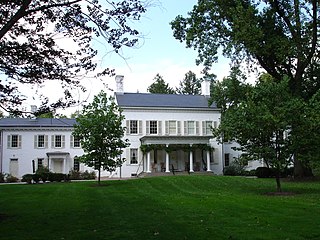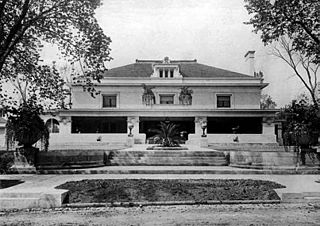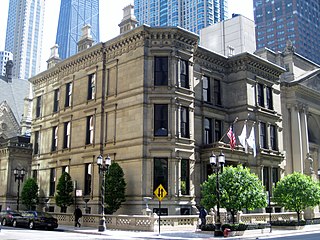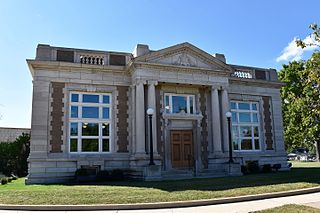
Grouseland, the William Henry Harrison Mansion and Museum, is a National Historic Landmark important for its Federal-style architecture and role in American history. The two-story, red brick home was built between 1802 and 1804 in Vincennes, Indiana, for William Henry Harrison (1773–1841) during his tenure from 1801 to 1812 as the first governor of the Indiana Territory. The residence was completed in 1804, and Harrison reportedly named it Grouseland due to the abundance of grouse in the area.

Morven, known officially as Morven Museum & Garden, is a historic 18th-century house at 55 Stockton Street in Princeton, New Jersey. It served as the governor's mansion for nearly four decades in the 20th century, and has been designated a National Historic Landmark for its association with Richard Stockton (1730-1781), a signer of the United States Declaration of Independence.

The David Davis Mansion, also known as Clover Lawn, is a Gilded Age home in Bloomington, Illinois that was the residence of David Davis, Supreme Court justice (1862–1877) and U.S. Senator from Illinois. The mansion has been a state museum since 1960. It was added to the National Register of Historic Places in 1972 and was designated a National Historic Landmark in 1975.

The Grand Army of the Republic Memorial Hall, also known as the Greenhut Memorial, was constructed as a memorial to American Civil War soldiers in Peoria, Illinois, United States in 1909. It was designed by Hewitt & Emerson. The Classical Revival hall was dedicated to Joseph B. Greenhut, Captain of Company K, 82nd Illinois Volunteer Infantry Regiment. The building was added to the National Register of Historic Places on July 13, 1976, and was listed as an example of Beaux-Arts architecture. It is also listed as a City of Peoria Local Historic Landmark in March 1996.

Peoria Mineral Springs is 14,500-year-old natural spring in the city of Peoria, Illinois, United States. The site, also known as Spring Hill, is located on a hillside on the historic West Bluff between Martin Luther King Jr. Drive and Moss Avenue.

The Pettengill–Morron House, or simply Morron House, is a historic mansion located in the city of Peoria, Illinois, United States. This Second Empire style home is located in the local historic Moss-High District. The property was added to the National Register of Historic Places and is a City of Peoria Local Historic Landmark. It currently operates as a museum by the Peoria Historical Society.

Pleasant Home, also known as the John Farson House, is a historic home located in the Chicago suburb of Oak Park, Illinois, United States. The large, Prairie style mansion was designed by architect George Washington Maher and completed in 1897. The house was added to the U.S. National Register of Historic Places on June 19, 1972. Exactly 24 years later, in 1996, it was declared a National Historic Landmark by the United States Department of the Interior.

The Astor Street District is a historic district in Central Chicago, Illinois.

Schuyler Mansion is a historic house at 32 Catherine Street in Albany, New York. The brick mansion is now a museum and an official National Historic Landmark. It was constructed from 1761 to 1765 for Philip Schuyler, later a general in the Continental Army and early U.S. Senator, who resided there from 1763 until his death in 1804. It was declared a National Historic Landmark on December 24, 1967. It is also a contributing property to the South End–Groesbeckville Historic District, listed on the National Register of Historic Places in 1984.

The Gottlieb Storz House is located in the Blackstone neighborhood of Midtown Omaha, Nebraska. Built in 1905 by Omaha beer magnate Gottlieb Storz, the mansion was designated an Omaha Landmark on December 21, 1982, and was listed in the National Register of Historic Places on August 7, 1974. It was included in the Gold Coast Historic District when the district was listed in the NRHP on March 14, 1997.

Washington Park Historic District, also known as Washington Square is a historic district in and around Washington Park in the city of Ottawa, Illinois, United States. Washington Park was the site of the first Lincoln-Douglas debates of 1858 and is surrounded by several historic structures. The park was platted in 1831 and the historic district was added to the United States National Register of Historic Places in 1973.

The Samuel M. Nickerson House, located at 40 East Erie Street in the Near North Side neighborhood of Chicago, Illinois, is a Chicago Landmark. It was designed by Edward J. Burling of the firm of Burling and Whitehouse and built for Samuel and Mathilda Nickerson in 1883. Samuel M. Nickerson was a prominent figure in the rising national banking industry, who was said to have owned at one point more national bank stock than anyone else in the United States.

Prairie Avenue is a north–south street on the South Side of Chicago, which historically extended from 16th Street in the Near South Side to the city's southern limits and beyond. The street has a rich history from its origins as a major trail for horseback riders and carriages. During the last three decades of the 19th century, a six-block section of the street served as the residence of many of Chicago's elite families and an additional four-block section was also known for grand homes. The upper six-block section includes part of the historic Prairie Avenue District, which was declared a Chicago Landmark and added to the National Register of Historic Places.

The Jacob Kamm House, also called the Jacob Kamm Mansion, is a French Second Empire style mansion in Portland, Oregon, built in 1871. It was moved from its original location on SW 14th and Main to its current location in Goose Hollow in 1950 to make room for Lincoln High School's campus. It was purchased by preservationist Eric Ladd for $1,000 at auction and moved to its present location, along with two other houses Ladd was interested in preserving, at SW 20th and Jefferson, which was called "the colony."

The Dr. Kuno Struck House, also known as Clifton Manor, is a historic building located in the West End of Davenport, Iowa, United States. It was individually listed on the National Register of Historic Places in 1984, and on the Davenport Register of Historic Properties in 1996. The house, along with its garage, became a part of the Marycrest College campus and they were both listed as contributing properties in the Marycrest College Historic District in 2004.

The McClurg Museum is a renovated mansion in Westfield, New York that serves as the home of the Chautauqua County Historical Society. It is a volunteer-run museum containing various artifacts collected by the historical society along with an extensive library and photo collection. It is open to the public and local schools for educational purposes.

The Marian Anderson House is a historic home located in the Southwest Center City neighborhood of Philadelphia, Pennsylvania. Built circa 1870 in the same neighborhood where opera singer and civil rights advocate Marian Anderson was born 27 years later, this two-story, brick rowhouse dwelling was designed in the Italianate style. Purchased by Anderson in 1924, the same year she became the first African-American concert artist to record spirituals for a major American recording company, she continued to reside here until 1943. The house is currently home to the Marian Anderson Museum and Historical Society.

The Lincoln Branch Peoria Public Library is a Carnegie library located at 1312 West Lincoln Avenue in Peoria, Illinois. Built in 1910, the building served as the first dedicated library building on Peoria's South Side. The South Side branch library opened in 1903 in a building called the Neighborhood House; however, it had outgrown its space in the building by 1909. The city petitioned the Carnegie Foundation for funding for a new library and the Foundation provided a $20,000 grant for the building. The city passed a $2,000 annual tax to cover the library's maintenance. Peoria architecture firm Hotchkiss & Harris supplied a Classical Revival design for the building, and construction began in 1910 and was completed the following year. The new building was dedicated on June 16, 1911.



















